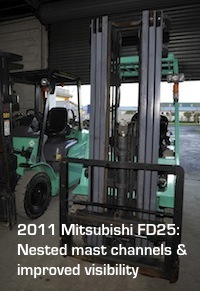Forklifts changes over the years (Part 1)
Over the next couple of months, we want to celebrate our 30 year anniversary by highlighting some major changes in forklifts technology since the Mitsubishi brand was first introduced to the New Zealand market in the early 1980s. Thus, we are making preparations for that. Also, many of these changes have been evident across the market, with all brands benefiting from, and participating in, the gradual enhancement of the product. The end result is a superior product, at a lower cost. these product developments generally have their origins in product safety, cost savings, or market acceptance.
Of course, since Centra Forklifts evolved from the last New Zealand company to manufacture forklift’s, Centra has special interest in the market changes. Hence, Centra continues to have strong links to this historic phase in New Zealand industry. Not only does Centra retain several staff with links to the manufacture of forklifts, but the association lives on in the form of inherited expertise, and company memorabilia. Hence, this experience differentiates Centra in the market through market expertise and technical specialisation.
The first article in this series covers the dramatic changes
The first article in this series covers the dramatic changes that have occurred in such areas as visibility, stability, and manoeuvrability. Although, our next article will focus on engine and fuel changes, and the evolution toward a more comfortable product.
Very noticeable loud steel to steel noise as each section bottomed when closing. Then The hydraulic lift centre cylinder when to the top of the mast.Improved visibility (previously the operator had to lean out the side of the forklift to look around the mast). This is large in diameter, compared to current rollers.
The chains are hidden behind the lift cylinder. So, lift cylinders are placed behind the mast channel. Hoses were externally mounted on the mast using take-up reels. Also, hoses are internally reeved, while the visibility does not get obscured. Hence, the mast channels were stepped forward of each other by 10 mm.
| ITEM | BEFORE | NOW | BENEFIT |
|---|---|---|---|
Mast structure and design |
Hydraulic cushioning, with mast lowering smoothly. | Noise reduction, operator comfort. Less product damage. | |
Hydraulic lift cylinders on container masts |
Now you can see over the top of the centre cylinder. | ||
Mast chains on container masts |
The chain went to the top of the mast. | It improved visibility. | |
Outer lift cylinders |
Cylinders ran down the inside of the mast. | Provides a panoramic view through the mast. | |
Side shifts and attachment hoses |
|||
Mast channels |
Mast channels are now nested – the front faces of all three channels are in line. |
20mm reduction in the lost load. | |
Mast rollers |
Reduced diameter of the mast rollers. | Better stability by reducing the lost load centre. | |
Carriage finger bars |
Wide bars. | Reduced width. | Improved visibility. |
Steer axles |
Axles included drag links, tie rods and quadrants and the wheels turned 308 degrees from lock to lock. | Axles now involve a single-steer cylinder and linkages to teh wheels. Hence, the wheels turn 336 degrees from lock to lock. | A significant reduction in the number of parts. Also, greater manoeuvrability in tight spaces. |


